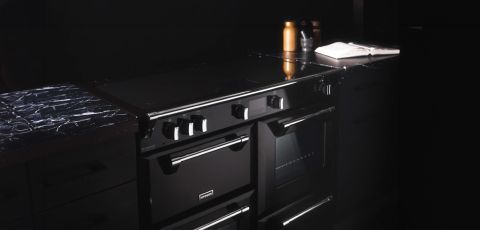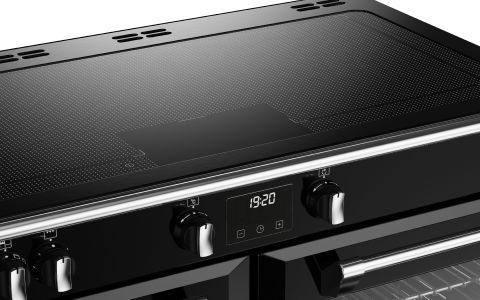
Centenary Eccles Cakes
If you haven’t lived in the UK, you might not know what an Eccles cake is. They are a very traditional bake, made up of a filling of currants & spices encased in flaky pastry. The name comes from the town of Eccles which is near Manchester. They’re very moreish and go extremely well with a cup of tea, of course. You can eat them warm from the oven or at room temperature.
Stoves, began as a manufacturer of gas heaters when founded in 1920 on valentine’s day! They moved on to make gas cookers and eventually range cookers which they are still a leading manufacturer of in the UK today. To celebrate Stoves’ landmark 100th year, I was tasked with making a recipe from a 1920s cookbook. Although there were many classic pastries in the book, the Eccles cakes were something I had always wanted to make so I settled on that recipe.
The ingredients are quite basic, a lovely buttery flaky pastry is made, rolled out, and cut into disks. A filling of currants, mixed peel, cinnamon, nutmeg, butter, and sugar is stirred together and spooned onto each circle. The edges of the circle are gathered at the top and pinched together to seal the filling within a layer of pastry.
These are little pastries, similar in size to a cookie, as they are quite rich from all the butter & dried fruit! This batch makes quite a few Eccles cakes, and although they’ll keep well for ~5 days in a sealed container, you can also freeze them if needed.
Although it is traditional to use lard in flaky pastry (in place of all or some of the butter), I go for all-butter. So yes, these Eccles cakes are vegetarian, but some that you might buy from traditional bakeries will contain lard.
--------------------------------------------------------------------------
Preparation Time: 30 Minutes
Cooking Time: 20 Minutes
Serves: 6
Ingredients:
- 226g white bread flour
- ½ tsp fine table salt
- 170g unsalted butter, cubed
- 70ml very cold water
- 120g currants
- 40g chopped mixed peel
- 40g caster sugar
- 1 tsp ground cinnamon
- ¼ tsp freshly grated nutmeg
- 40g unsalted butter, melted
- 1 egg, beaten
- Demerara sugar, for sprinkling
Method:
- Combine the flour and salt in a large bowl. Add the cubed butter and rub in with a pastry blender/a pair of butter knives/your fingertips until the majority of the mixture has a breadcrumb-like texture with some pea-sized lumps of butter remaining. (If you have a food processor or stand mixer with the paddle attachment, you can also do this step in there, pulsing to combine until you reach the consistency mentioned).
- At this stage, drizzle in the cold water and gently toss to combine. Give it a bit of a knead in the bowl until the dough starts to come together then tip the shaggy mass out onto your work surface. (Again, if doing this in a food processor/stand mixer, just pulse until the mixture starts to come together then tip out).
- Gather the mixture into a mound and use a rolling pin to roll it out into a smallish rectangle. It will likely seem very messy and might stick to the rolling pin, this is fine! Just scrape any dough off the rolling pin and add back to the rectangle. Fold the rectangle into thirds like a business letter. Rotate the dough 90° then roll out into a rectangle again. Fold into thirds again. Then use your hands to press down to compact it into a nice little package. Wrap in a resealable sandwich bag and chill for at least 1 hour.
- Mix the currants, mixed peel, sugar, cinnamon, and nutmeg in a medium bowl. Stir to combine then pour over the melted butter. Stir again to incorporate and set aside.
- Roll out and shape:
- Preheat your oven to 200°C fan (400°F) and line a baking tray with baking paper.
- Remove the chilled dough from the fridge and from the sandwich bag. Roll the dough out on a lightly floured work surface, dusting with flour on top as needed to prevent the dough from sticking to the rolling pin. Also, make sure you’re checking underneath the dough as you do this by gently lifting the edges up and dusting flour underneath as needed to prevent it from sticking to the work surface. The dough should be about 3 to 4mm thick.
- Use a 4-inch (10cm) round cutter to cut circles from the dough. Place a teaspoonful of filling in the centre of each circle. Wet the edges of the circle with a fingertip dipped in some water. Gather the edges up at the top and pinch together to seal the filling within. Flip over so the seam side is underneath and place onto a lined baking tray. Repeat with all the circles, re-rolling pastry scraps as needed until you’ve used all the filling/pastry.
- Cut 3 slits into the top of each Eccles cake with a sharp knife. Brush with the beaten egg and then sprinkle with some demerara sugar. Bake for 15 to 20 minutes until well browned.
Recipe from "The Downstairs Cookbook: Recipes From A 1920s Household Cook" by Margaret Powell.

